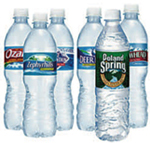
| CONNECTIONS |
IDAHO
ITD
HOME
511 TRAVEL SERVICES
IDAHO
DMV
ITD
NEWS
HIGHWAY
SAFETY
IDAHO STATE POLICE
STATE OF IDAHO
NIATT
NATIONAL
AASHTO
AAMVA
AAA of IDAHO
FEDERAL HIGHWAYS
FEDERAL AVIATION
IDAHO STATE POLICE
NHTSA
NTSB
TRB
U.S. DOT
TRANSPORTER
Archives
Milestones
Comments
Idaho
Transportation
Department
Office of Communications
P.O. Box 7129
Boise, ID 83707
208.334.8005
Fax: 208.334.8563

Emergency kits should contain adequate water supplies
The Ada City/County Emergency Management office provides the following emergency preparedness ideas:
Water when you need it
Have you ever experienced the inconvenience of having the water shut off to your home for repairs? People all over the United States are quite used to walking up to a faucet, turning a knob and getting clean water.
This convenience is often taken for granted. A large-scale earthquake, flood or chemical incident could shutdown the municipal water system for days. In such a case, your only guaranteed water supply would be the water you have stored.
How much Water do you need?
It is best to purchase food-grade water storage containers from surplus or camping supplies stores to use for water storage. If you are going to re-use liquid containers, choose two-liter plastic soft drink bottles. Do not use plastic jugs that have had milk or fruit juice in them.
Cleaning will not completely remove the milk protein and fruit sugars from these containers. These lingering elements provide an environment for bacterial growth in stored water.
 Water storage other than commercially bottled water
Water storage other than commercially bottled water
If you are using plastic soft drink bottles, sanitize the bottles by adding a solution of 1 teaspoon of non-scented liquid household chlorine bleach to a quart of water. Swirl the sanitizing solution in the bottle so that it touches all surfaces inside the bottle. When you are done sanitizing the bottle, thoroughly rinse out the sanitizing solution with clean water.
The recommended amount of water to keep stored as part of your 72-hour kit is one gallon per person per day. It should be kept in a cool place, away from direct sunlight and convenient for quick loading into your vehicle in case of an evacuation.
There are a number of different means of storing the water. One of the easiest and safest methods of storage is to keep cases of bottled water. To meet the minimum requirements for water, individuals need to stock one 24-bottle case of the 0.5 liter bottles per person. The supply should be rotated annually or by the expiration date noted on the bottle, whichever comes first.
Commercially bottled water has already passed tests for contaminants and has a
tight seal to help prevent any future contamination.
Proper preparation and replacement procedures:
-
Thoroughly clean the bottles or jugs with dishwashing soap and water. Make sure all of the soap residue is completely rinsed out.
-
After you have prepared the container, fill it to the top with regular tap water.
-
Local water utility companies treat tap water with chlorine, so you won’t need to add anything else to the water to keep it clean. However, if you are using water from a well or other non-chlorinated water source you will need to add two drops of non-scented liquid household chlorine bleach to each gallon of water.
-
Seal the container by tightly closing it with the original cap. Be careful not to touch the inside of the lid with your fingers. Doing so can contaminate the water. Clearly mark each bottle with the date of fill.
All water that you bottle yourself needs to be replaced once every six months.
Keep in mind that a three-day water supply is a bare minimum amount suitable for evacuating your household in an emergency. If you have the ability and room to do so, maintaining a two-week supply of water will make you better prepared for a broader array of circumstances including sheltering in place for an extended period.
Published 7-3-09